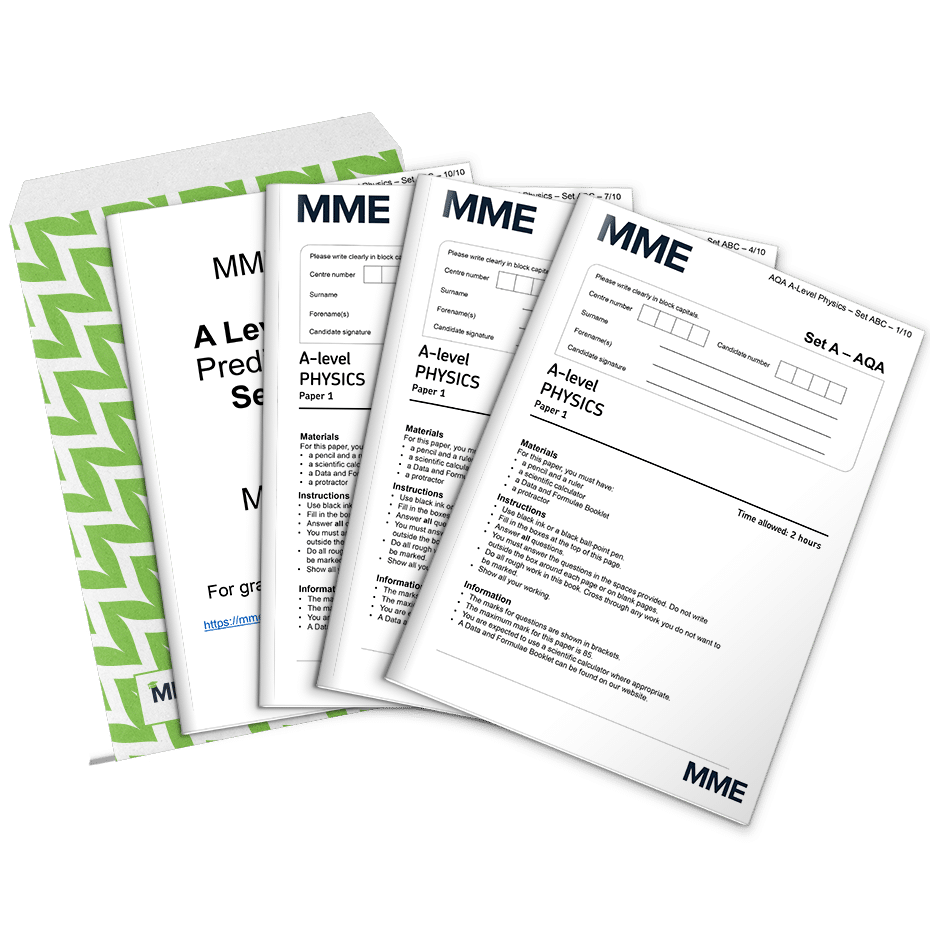SI Units and Prefixes
SI Units and Prefixes Revision
SI Units and Prefixes
SI units (The International System of Units) are essentially the basic units from which all other units are derived. It is important to learn the common units for physical quantities, but you may also be asked what these units are in terms of their base units.
Fundamental (Base Units)
There are 7 SI Base units that make up all the other units we use in physics. For this course, we only need to learn about 6 of the 7 base units. The base unit for light intensity (the candela) does not need to be leant for the AQA course.
SI Base units are important to physics as they are the same in all languages and hence are used universally. Other units not in this list may be different in different languages or different units may be used in different countries. The 6 base units are:
|
Quantity |
Base Unit |
Symbol |
|
Length |
Metre |
m |
|
Time |
Second |
s |
|
Mass |
Kilogram |
kg |
|
Temperature |
Kelvin |
K |
|
Current |
Ampere/Amps |
A |
|
Amount of a Substance |
Mole |
mol |
Derived Units
A derived unit is comprised of a combination of the above SI Base units. There are many more derived units than SI base units and these are the units you will be familiar with such as Newtons \left(\text{N}\right), Joules \left(\text{J}\right), Hertz \left(\text{Hz}\right) and many more.
Each unit you use in physics can be broken down into its SI base units either by using the definition of the unit or by the equation for the quantity that the unit describes. You will come across many of these in this course.
Prefixes
A lot of the units we cover in A Level physics will involve the use of very large or very small numbers. By using prefixes in front of units we can avoid having to write very large or small numbers out in full. For example, we may be looking at a wavelength of light that is 0.000000656 \text{ m}. Instead of writing this out each time, we can use the prefix nano \left(\text{n}\right), and write out wavelength as 656 \text{ nm}. A full list of the prefixes you need to know can be found below:
|
Prefix |
Abbreviation |
Number |
Power of 10 |
|
Terra |
T |
1000000000000 |
1012 |
|
Giga |
G |
1000000000 |
109 |
|
Mega |
M |
1000000 |
106 |
|
Kilo |
k |
1000 |
103 |
|
Centi |
c |
0.01 |
10-2 |
|
Milli |
m |
0.001 |
10-3 |
|
Micro |
u |
0.000001 |
10-6 |
|
Nano |
n |
0.000000001 |
10-9 |
|
Femto |
f |
0.000000000001 |
10-12 |
Standard Form and Converting Units
Sometimes we are given numbers with units using the prefixes above. We cannot use these numbers into our calculations so we need to ensure we convert back to full numbers for our calculations.
Example: Calculate the speed of a wave with wavelength 500 \text{ nm} and frequency 3.9 \text{ GHz}.
[3 marks]
To calculate this we need to convert \text{nm} and \text{GHz} back to \text{m} and \text{Hz}. We can use the table above for a guide.
500\text{ nm} becomes 500 \times 10^{-9} \text{ m} and 3.9 \text{ GHz} becomes 3.9 \times 10^{9} \text{ Hz}.
Now we are ready to calculate using \text{velocity} = \text{wavelength} \times \text{frequency} (found on your data sheet).
500 \times 10^{-9} \text{ m} \times 3.9 \times 10^9 \text{ Hz} = \bold{1950} \textbf{ms}\bold{^{-1}}
Common Conversions
Across the physics course you will often need to convert between equivalent units. An equivalent unit is another unit given to the same quantity. For example energy could be measured in Joules or Calories. Here are a couple of useful conversions for you should know and be able to recall where needed:
Joules to electronvolts (\text{J to eV}):
- To convert from \text{J} to \text{eV} you need to divide by 1.6 \times 10^{-19}
- To convert from \text{eV} to \text{J} you need to multiply by 1.6 \times 10^{-19}
These conversions are particularly useful when dealing with very low quantities of energy.
Joules to kilowatt-hours \text{(J to kWh)}
- To convert from \text{J} to \text{kWh} you need to divide by 3.6 \times 10^6 (amount of energy used by a 1\text{ kW} appliance in 1 \text{ hour})
- To convert from \text{kWh} to \text{J} you need to multiply by 3.6 \times 10^6 (amount of energy used by a 1\text{ kW} appliance in 1 \text{ hour})
These conversions allow you to work out how much energy has been used by an appliance over a period of time.
Example: Deriving Units
Deriving the Newton into its base units can be done by finding an equation that produces an answer in Newtons. One you will be familiar with from GCSE is F = ma. If we write this equation out using only its units we can come up with a way of writing Newtons in SI Base units only.
Write the unit of force in its base units.
[2 marks]
\begin{aligned} F &= m \times a \\ \textbf{N} &= \textbf{kg } \bold{\times} \textbf{ ms} \bold{^{-2}} \end{aligned}
Therefore:
N = \textbf{kg m s}\bold{^{-2}}
Look out for more of these derivations throughout the course.
SI Units and Prefixes Example Questions
Question 1: State the purpose of base units and give the base units for time and length.
[3 marks]
Base units can be used by scientists all around the world and are a standard way of writing physical quantities. The base unit for time is seconds and the base unit for length is the metre.
Question 2: Using the equation listed and the SI base units, what would the SI base units for Joules be? (\text{kinetic energy} = 0.5 \times \text{mass} \times \text{velocity}^2)
[2 marks]
Question 3: Write the unit for charge (Coulombs, C) in its SI base units using an appropriate equation from your data sheet.
[3 marks]
\begin{aligned} \textbf{charge} &= \textbf{current} \bold{\times} \textbf{time} \\ \text{C} &= \textbf{A} \bold{\times} \textbf{s}\end{aligned}
Therefore the SI units for Charge are \textbf{As (Amp seconds)}








